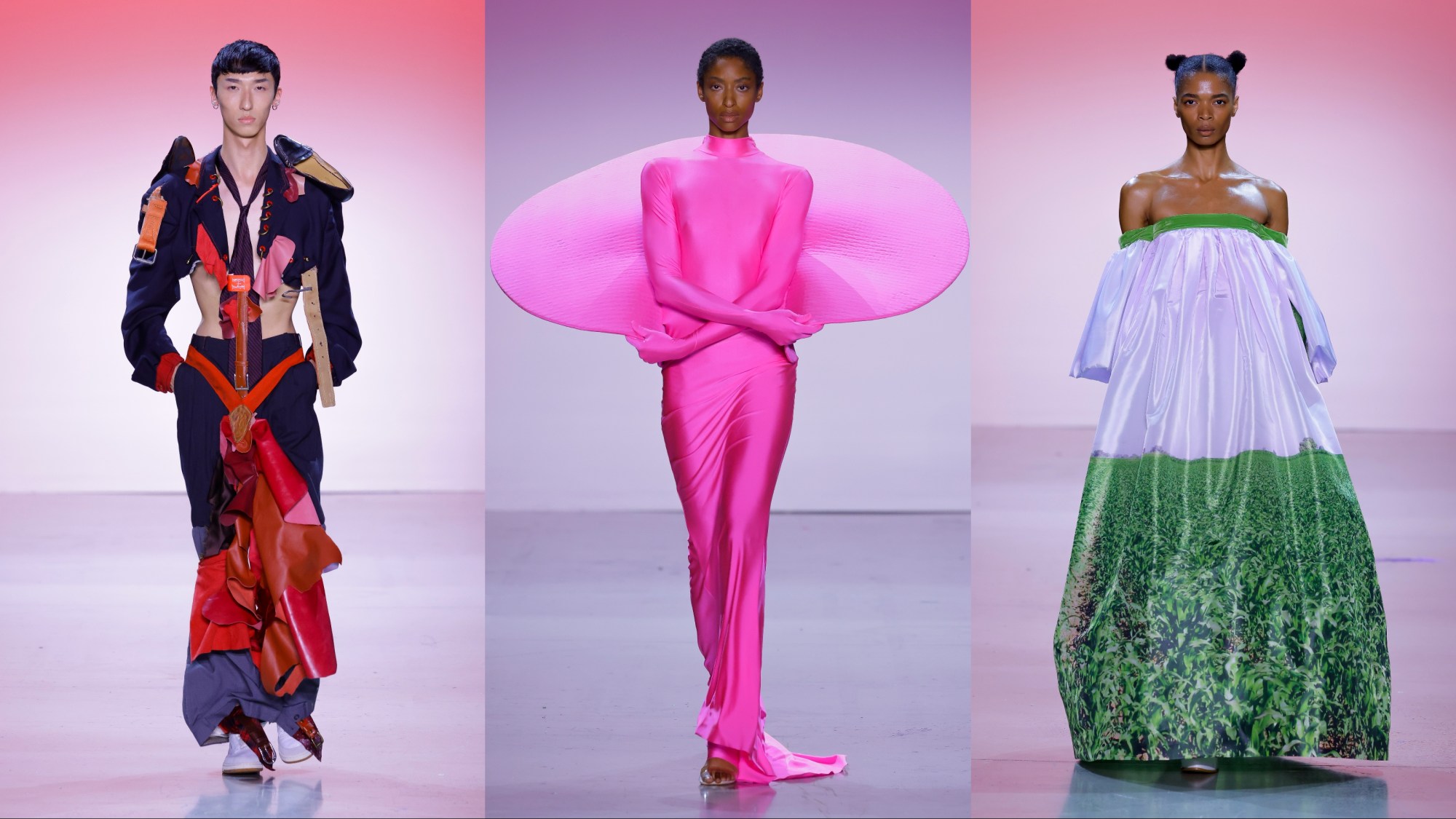Exploring themes such as sexuality, technology, intergenerational relationships and fungi, Fashion Institute of Technology’s (FIT) Fashion Design MFA Class of 2023 presented a combined 112 looks this week at UNI/VERSAL, a show dedicated to graduate students. The looks — which ranged from romantic silks to geometric structures on wheels — went beyond clothing, doubling as dissertations on the state of fashion and its relation to the environment, gender and identity. Despite addressing overlapping matters, each collection revealed a unique point of view grounded in experience and curiosity.
“Throughout their two years in the program, these talented 2023 graduates have been guided by a gifted and experienced faculty of creatives and industry professionals,” said Cathleen Sheehan, chair of the Fashion Design MFA program. “We’ve all been impressed by their collaborative spirit and commitment as students, and look forward to the positive impact they’ll make as emerging fashion designers.”
Highlights from the show included a silver midi skirt and top crafted from architectonic, origami-like textiles made by Chinese-born, New York–based Luna Zining Ye, an off-the-shoulder maxi dress printed with a photo of green farmland by multidisciplinary artist and young designer Valeria Watson, and an ethereal white look finished with silk ribbons by award-winning designer Deborah Won (at the end of the runway, each model wearing Won’s clothing paused and hopped, driving home her focus on zero gravity and taking flight).
As standalone collections, each grouping of looks revealed its designer’s sense of imagination and ability to push the limits of clothing. Together, FIT’s top graduate designers made a case for a promising future for fashion, one that considers how what we choose to wear impacts the way we think and live. Meet some of the standout grads and get to know their work, below.
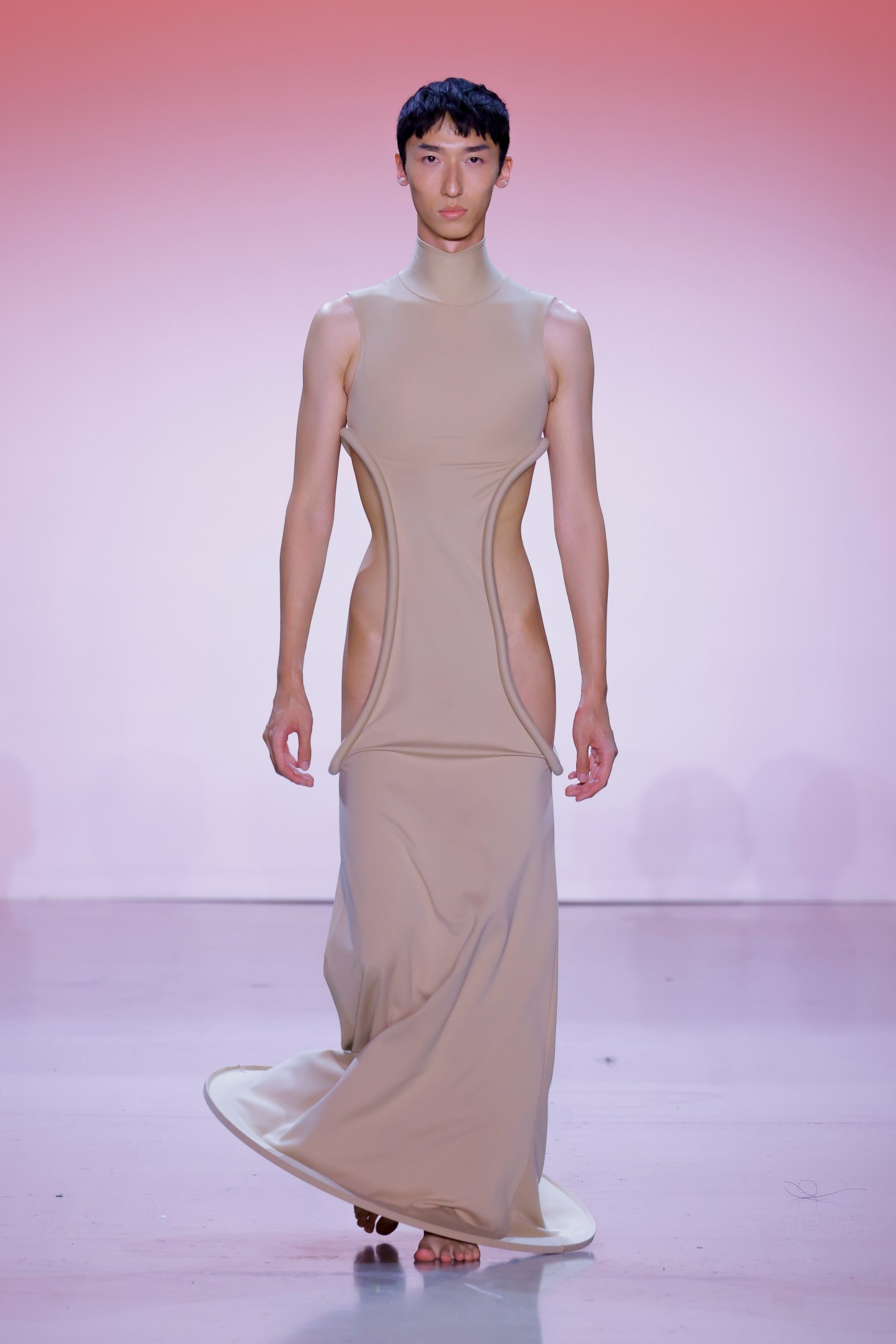
Youna Jin
Where do you look for inspiration?
I get inspiration from art in any form that engages with body and diversity. They inspire me in terms of colour, and also by suggesting new forms of body. Also, I love any ironic concept that makes me think.
What story, idea or concept was central to this collection?
My thesis collection ‘SOFT DISCOMFORT’ was inspired by ironic usage of unisex fashion these days. The term “unisex” emerged to combat gender norms. While unisex was used in the women’s liberation movement to advance sexual freedom, it frequently takes on the structure of making women masculine and men feminine. I think this tendency perpetuates fixed gender images rather than promoting individual body images.
Therefore, I chose to use progressive pattern cutting to organically showcase controversial parts of the human body in order to highlight each individual’s unique body image. I hope the audience will think about this statement through my works, which are devoted to highlighting and exposing the body itself.
What modern designers inspire you today?
Rick Owens and Helmut Lang.
What is your first-ever fashion-related memory?
When I was 14, I loved collecting my favourite pages from fashion magazines to draw.
Where do you see yourself as a designer in the next five years?
I’m currently working at a fashion company, but after I get more industry experience, I want to make my own brand.

Morgan Cardwell
Where do you look for inspiration for your work?
I find my inspiration from the natural world – plants and fungi, in particular. I grew up in a family of landscape architects and have always been fascinated with the vast range of forms that appear around us, even in the most obvious of places. This led to my undergraduate work looking for pattern inspiration in microbiology, which then evolved into my graduate work examining fractal patterns.
What were you hoping to communicate to your audience with this collection?
I wanted to explore the interconnection between humans — with emotions, each other and the natural world around us. I used bold colours, rich textures and fractal-inspired textiles to create a “pause in the chaos”, for viewers to reflect on this concept. I also love seeing the connections people find in the imagery, we all have different experiences and relate to our own interpretations of the patterns. While I might see topographic contours, someone else might see coral from their last diving trip or foliage from their childhood yard. It’s about finding the connection in these experiences.
What modern designers inspire you today?
Loewe, Christopher Kane, Rahul Mishra, Iris Van Herpen.
What was the most challenging part of creating this collection?
The most challenging part for me was finding the balance between my perfectionism and the time constraints of a two-year program. The process of developing my textiles requires multiple iterations and experiments before reaching a point where I feel satisfied that I’ve found the right solutions to the challenges I’m exploring. There were times when I had to let go of control and let the textiles tell me how they want to lay, rather than me trying to force them into a specific parameter. It’s more of an intuitive process.
What encourages you to keep going, especially in a fashion world that needs solutions?
I’m motivated by the moments when I see my work impact someone else in a positive way. Like seeing someone smiling when they try on a garment or seeing models taking selfies because one of my looks resonates with them. It’s the potential of offering more green solutions in the future or exploring biomimicry that feels like an opportunity to use my skill set beyond just making beautiful things.
What is your first-ever fashion-related memory?
My grandfather ran textile mills in Virginia and North Carolina. He always kept extra fabric and old knitting machinery in our garage, so I grew up pretending to use the machinery and playing with the overstock fabric laying around. My sister and I would drape ourselves in cloth when we played make-believe. I think this playful, childlike wonder still shows in my work today.
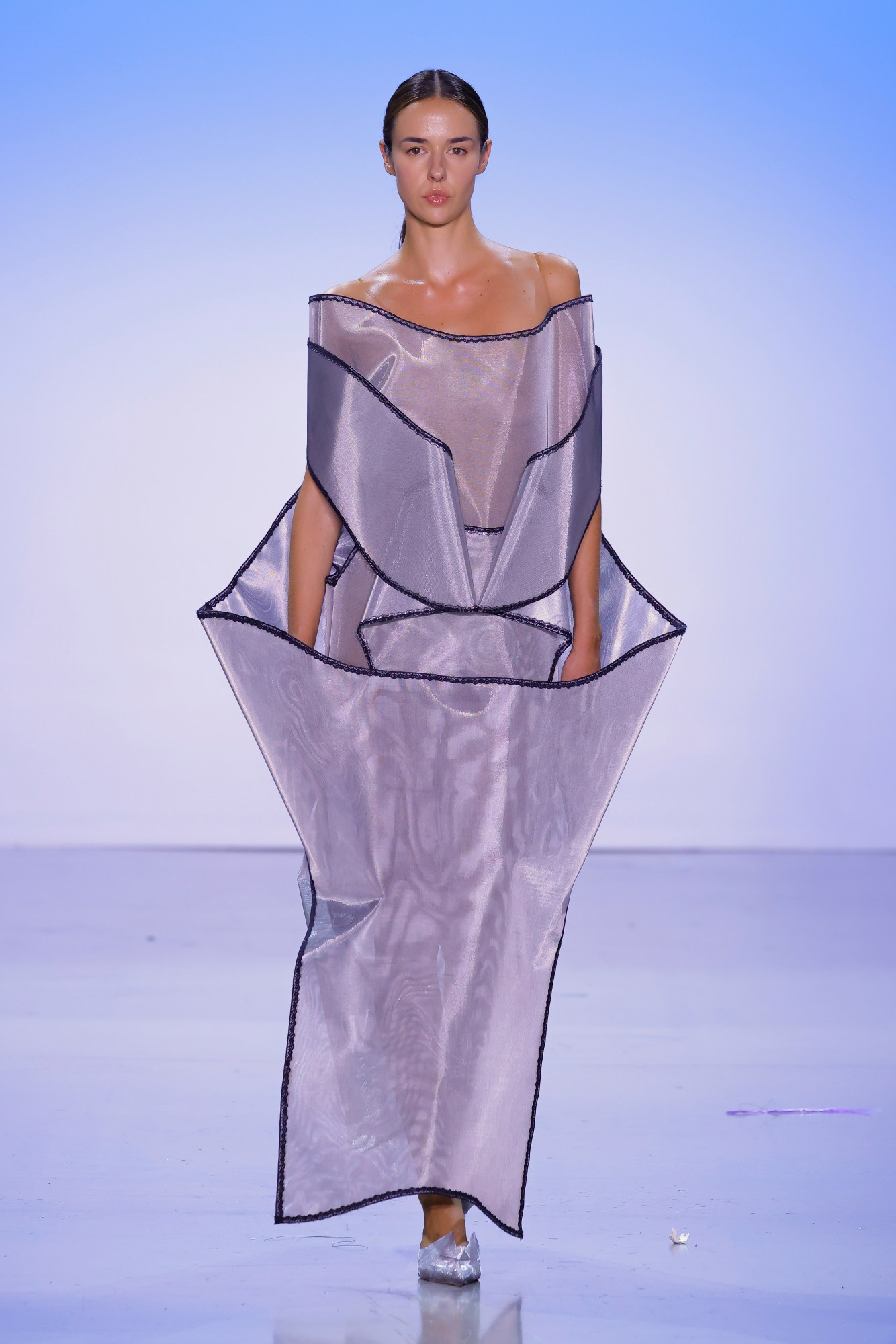
Luna Zining Ye
Where do you look for inspiration for your work?
I usually get inspiration from my experience and the artists I like, for example, Robert Rauschenberg. I like to spend time in galleries and exhibitions outside of fashion. The questions I ask myself drive my curiosity. Sometimes the ideas strike me randomly and I will immediately record them by sketching them down.
What story, idea or concept was central to this collection?
In Asian culture, restraint is a central theme. I began my collection from my curiosity about my grandmother’s generation and the social-cultural constructs of her era. Despite external suppression of individualism during that era, internal expression and freedom persisted. My collection, ‘Fancy Inside’, seeks to represent the friction of internal and external worlds by playing with the juxtaposition of fluidity and rigidity, in form and textile, and mixing traditional Eastern crafts with modern materials.
What modern designers inspire you today?
Hussein Chalayan, Schiaparelli.
What was the most challenging part of creating this collection?
To figure out the techniques and finishing of origami textiles, which are inspired by the game we all played when we were kids — fortune paper teller. I wanted the collection to have a finish with no threads and visible closures, to most resemble paper origami.
What is your first-ever fashion-related memory?
I had one dress with a unique and interesting pattern that I can play with when I wear it. I enjoy fashion being used as play, as it is the closest thing we keep to our bodies at all times.

Valeria Watson
Where do you look for inspiration for your work?
I take inspiration from personal memories, as well as stories that are passed down through my family and friends. When designing, I look back at pictures that I or relatives have taken. I try to imagine where they were going, why they decided to capture this moment and who they were with while taking the picture.
What were you hoping to communicate to your audience?
‘Sabor a mí, Sabor a tí’ talks about Mexico and the United States’ long history of population migration between each other, leading to a rich cross-cultural blend of cultures. This collection explores my own multicultural heritage as half-American and half-Mexican. Through hand weaving and digital prints plucked from childhood photographs, I used this collection to tell my family’s migration history and to record the stories that have been passed down through generations.
What modern designers inspire you today?
Lirika Matoshi and Daniel Roseberry.
What was the most challenging part of creating this collection?
The biggest challenge was for it to look like a collection. Each garment is inspired by a different story. Some are inspired by my American heritage, while others are inspired by my Mexican heritage and some from both. Keeping the garments speaking to each other, while still having them tell their own story was something I had to keep going back and forward with.
Which piece in this collection are you most excited about?
My ‘American dad look’, it’s a look created fully with my dads upcycled shirts. It’s a meaningful for me because I have pictures and memories of my dad wearing all these shirts. My mom helped me gather the shirts and drape them to create a unique look.
What encourages you to keep going, especially in a fashion world that needs solutions?
I am a strong believer in sustainability and upcycling. I upcycle many of the garments for this collection, and those are the ones that usually get the most attention. It gives designers opportunities to be more creative.
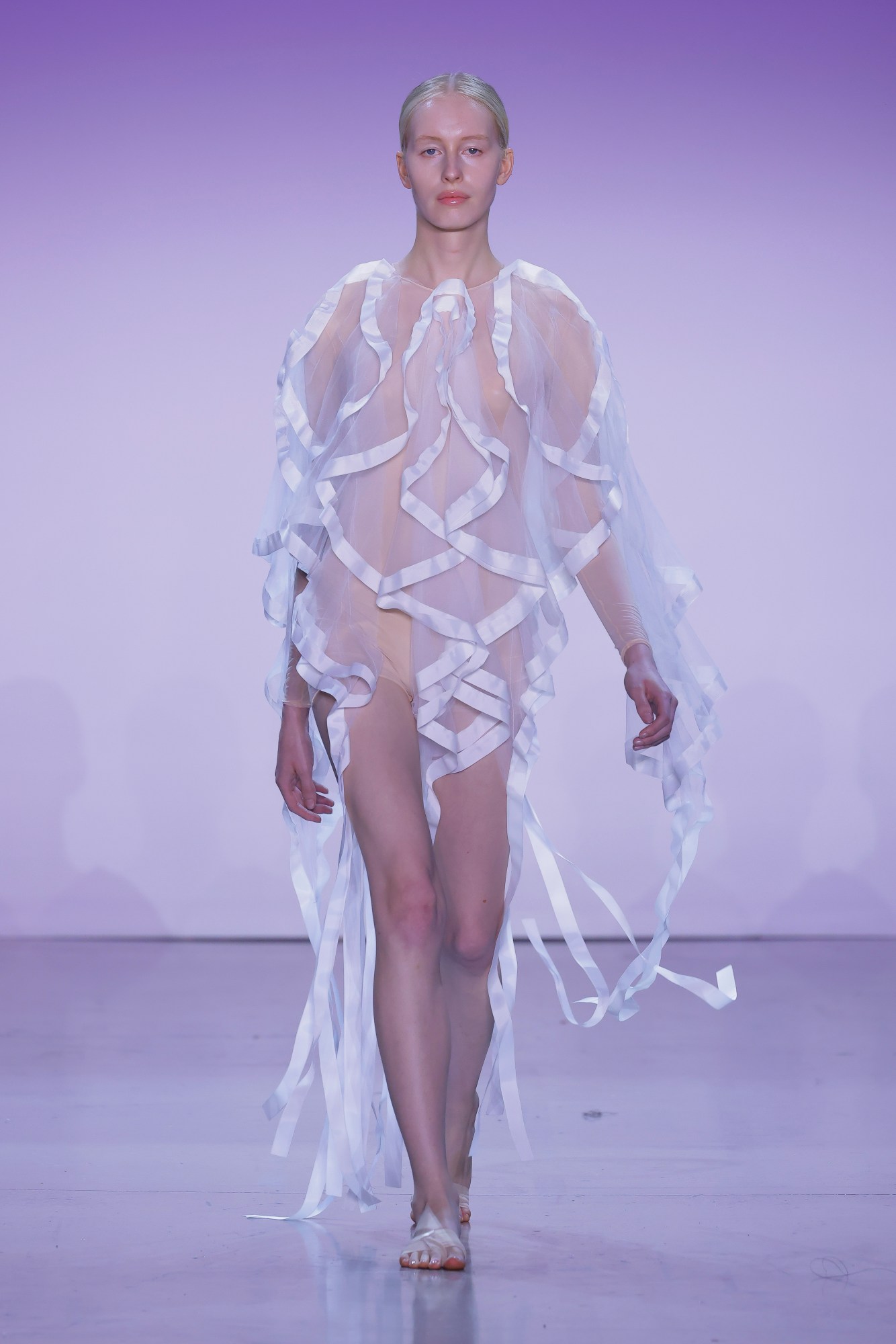
Deborah Won
What were you hoping to communicate to your audience?
Exploration is a fundamental aspect of human culture. It looks like commercial space travel is imminent, and wherever people are, there will be a need for adornment. ‘Arise’ is a statement on how our collective lifestyles will change in the future.
The premise behind the garments is that humans will visit environments outside of Earth’s atmosphere and therefore must be designed to enhance movement in zero gravity. The wearers bloom as they transition from 1G (earth-gravity) to space (0G), in that the ornaments start by hanging to eventually hovering around the body. Some garments reveal contrast florals while others have kite tails that expand outward. What I hope people will see is that, contrary to the rigid and geometric space fashions of the past, clothes worn off earth can be fluid and even delicate.
What modern designers inspire you today?
Nicolas Ghesquière, Christophe Lemaire, Julien Dossena of Paco Rabanne and Iris Van Herpen.
What was the most challenging part of creating this collection?
The main challenge was being resolved in my choices. When you tell someone you’re making clothes for space, you’re breaking into new territory. I was afraid of taking a chance, and at times, struggled with the uncertainty. Having given birth at the start of the program, I was stretched for time and mental resources, but I took the journey moment by moment, knowing it would lead somewhere exciting.
I started with what I know, which is that the fit and performance of the garments were essential to the development of the collection. Because I did not have the benefit of actually being in 0G, I drew from exhaustive interviews I conducted with experts in the aerospace field to understand body mechanics and other kinaesthetic requirements. Whenever I got lost, I tried to imagine what feminine beauty could look like in a spaceship.
What encourages you to keep going, especially in a fashion world that needs solutions?
My daughter, Jane, is the source of my design optimism. I have to imagine an abundant and healthy world for her in order to work toward it. This is why sustainability and out of the box thinking is so crucial to what I do.
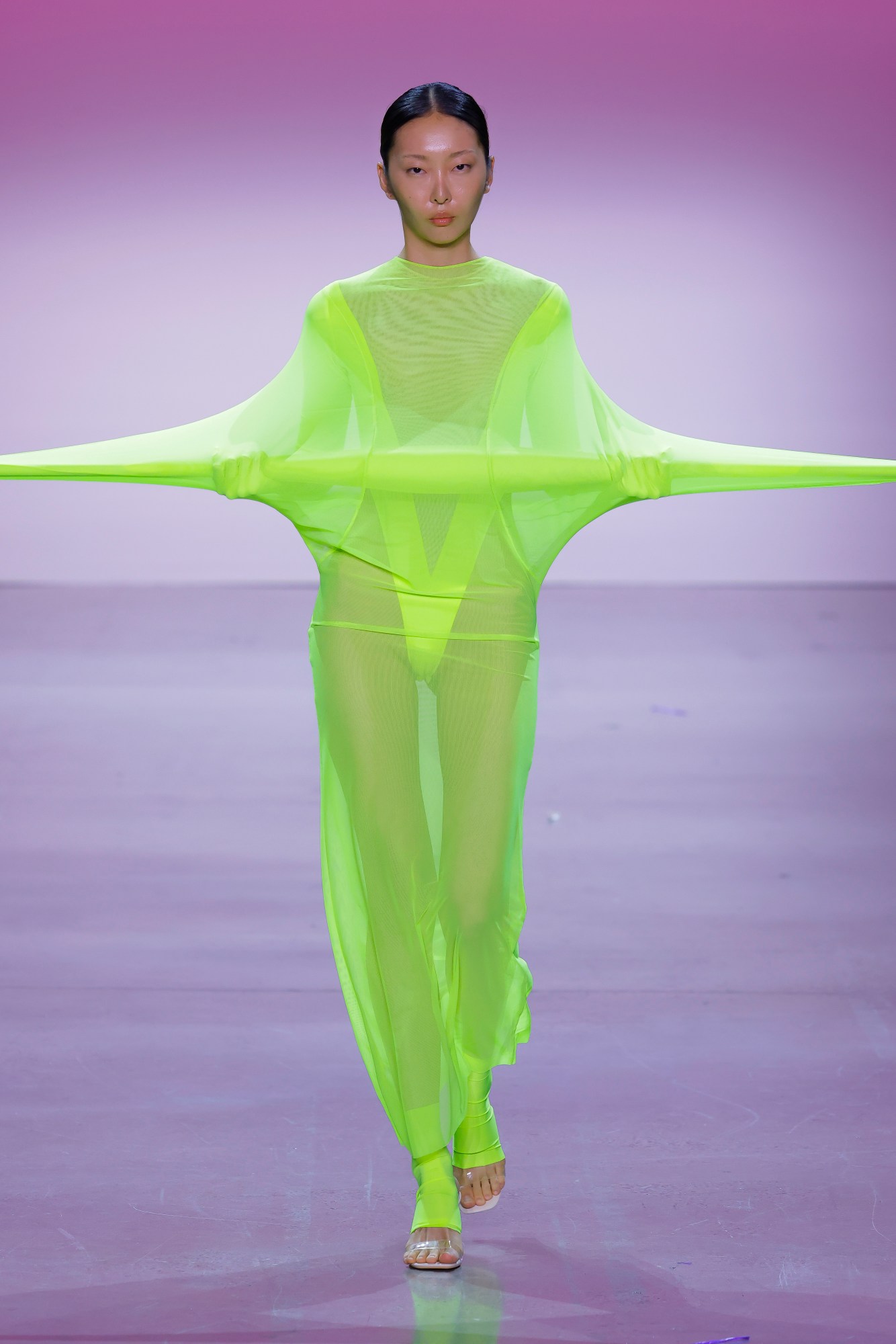
Kuai Li
What story, idea or concept was central to this collection?
This collaboration’s name is ‘Independent Reality’. I hope everyone will rethink the relationships between themselves and their surroundings. Also, rethink fashion as performance art.
Who do you see wearing this collection? Where are they going?
I would say like Beyoncé or Doja Cat for their performances.
What encourages you to keep going, especially in a fashion world that needs solutions?
The joy of exploring the boundaries of fashion and the possibilities of our generation’s fashion.
What is your first-ever fashion-related memory?
My roommate showed me Haider Ackermann’s designs, it was fascinating to me how elegant the garments were.
Where do you see yourself as a designer in the next five years?
As an independent designer and founder of Quine Li.
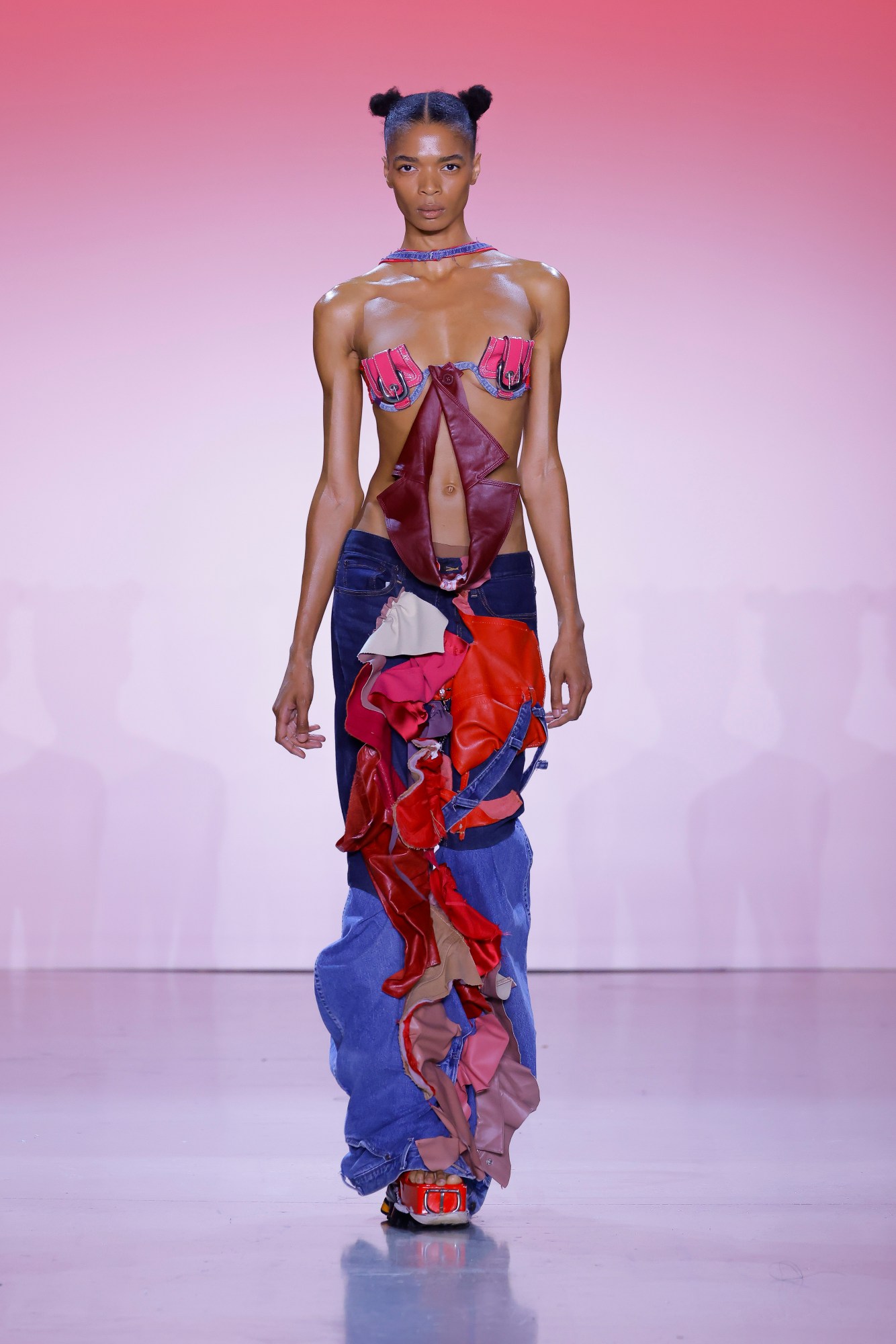
Kaylie Haieisen
Where do you look for inspiration for your work?
I take most of my inspiration from audacious subject matters that challenge today’s society. The mixing of feminine and masculine elements is the main focus that is consistent with my work. In this collection, I took it VERY literal.
What story, idea or concept was central to this collection? What were you hoping to communicate to your audience?
This collection is centred around women being allowed to express their sexuality in the same ways men have always been allowed to. Women always get shamed for liking sex, but men are expected to. As a bisexual woman, we are labeled as “too slutty” or “too greedy”. And I’m here to say, WHAT ABOUT IT? With all the genitalia that is going on in my collection, I want to communicate a sense of “who cares if I’m a slut?”.
What modern designers inspire you today?
Nicole McLaughlin, with her very unconventional way of creating wearable art with everyday items. The brand Namila uses genitalia in their work as well, which I have always admired and been inspired by.
Who do you see wearing this collection? Where are they going?
I see anyone who likes to push boundaries in my pieces. Doja Cat is a perfect example of someone I would love to dress. Julia Fox also gives an energy that matches my aesthetic. My customer wants to be seen and knows she’s going to piss people off but also thrives on that in a way.
Which piece in this collection are you most excited about?
I’m excited about my denim and pocket buckle bra top with the labia denim jeans. I like my use of materials and upcycling an item and using it in a very unconventional way. I actually got the pink pocket with buckles on an old used purse and turned them into bra cups.
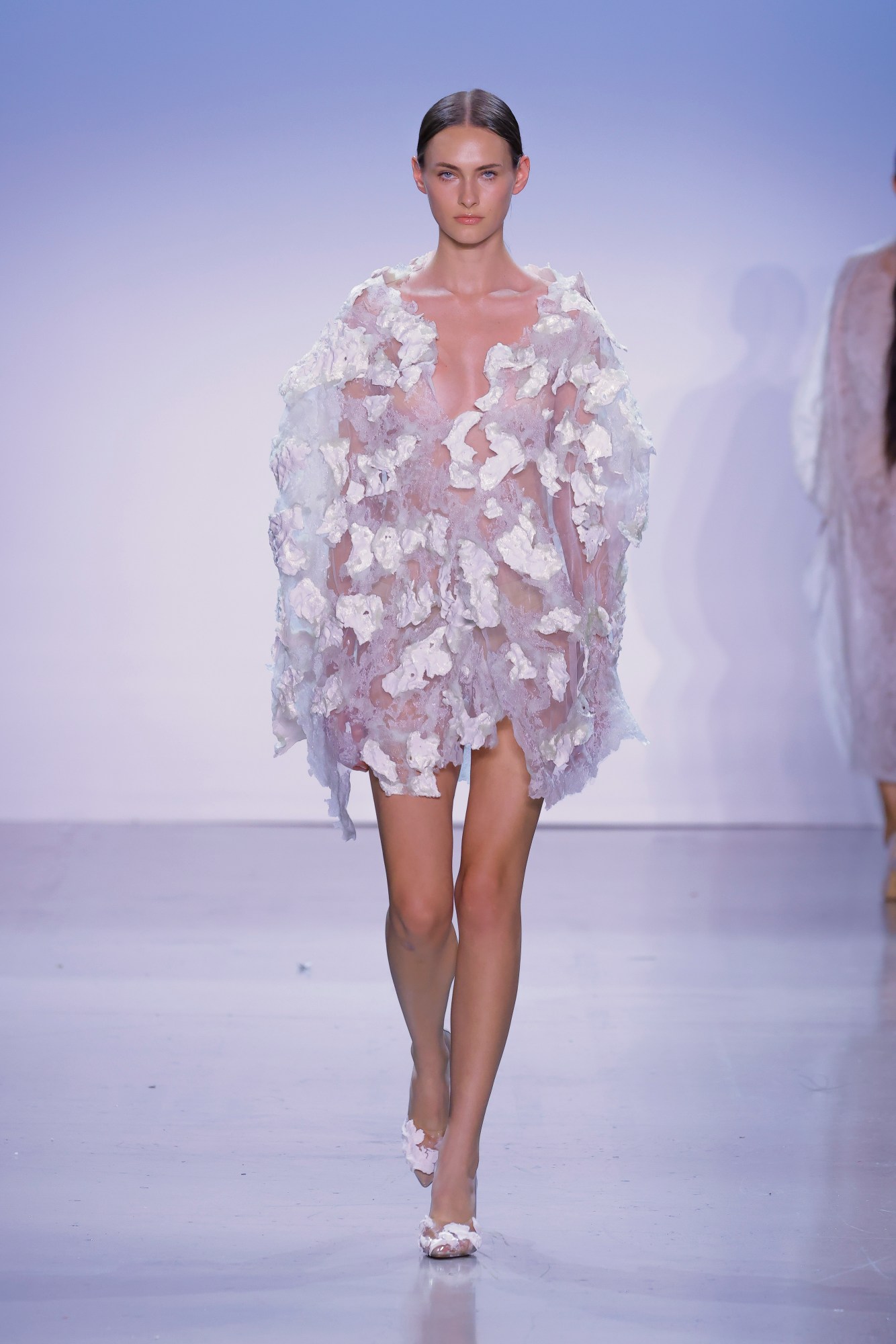
Tom Zhendong Wen
What story, idea or concept was central to this collection?
The ‘Metamorphosis’ collection was inspired by our relationship with modern technologies, such as cell phones and computer screens. It explored the transformation of our spines as they adapt to the screens we hold in our hands. The designs and patterns were derived from the morphed spine, symbolising an evolution that takes shape like a cocoon.
What modern designers inspire you today?
Cristóbal Balenciaga, his work is like poetry to me.
Who do you see wearing this collection? Where are they going?
Most of my fabric is pure silk. In my mind, it is someone who has expertise in their path, has matured enough in their journeys to take care of the fabric, and who knows what they want and have a certain taste level.
What is your first-ever fashion-related memory?
I remember seeing Yohji Yamamoto’s work, then I immediately fell in love with it. The perfect combination of art, poetry and commerce. His work touched me, it led me into fashion.
Where do you see yourself as a designer in the next five years?
I currently I sell bags I designed on my website. I plan to build my company in the future, and am looking for investors to help to accelerate the process.
Credits
All photos courtesy of Fashion Institute of Technology.
